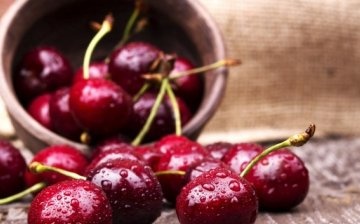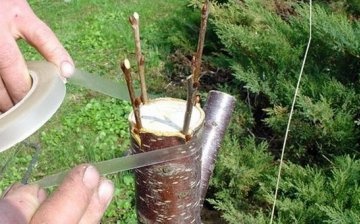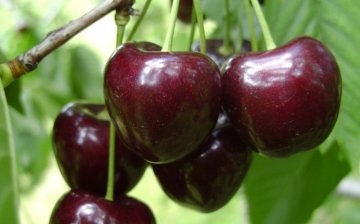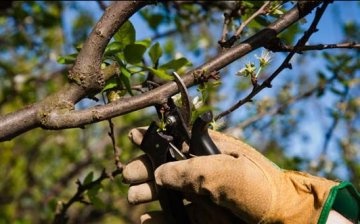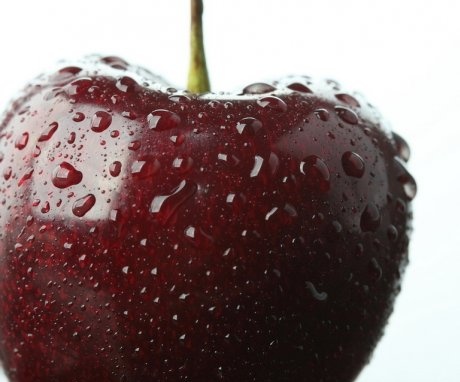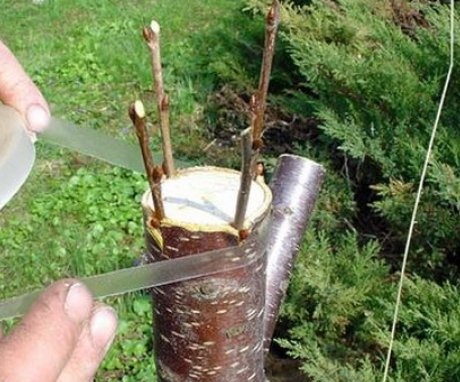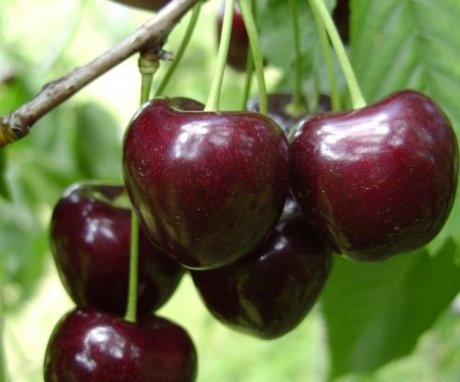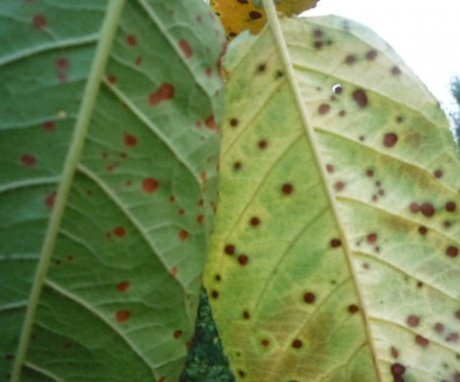Cherry Regina: features of the variety, cultivation and care
Cherry Regina is one of the most popular fruit crops. Dessert berry has good taste, and trees begin to bear fruit very early. Cherry Regina is in demand, and gardeners successfully grow it in gardens.
Maturation cherries occurs much faster than other stone fruit trees begin to bear fruit. Due to the content of glucose and fructose in berries, as well as vitamin C, calcium and potassium, succinic and malic acids, cherries are useful for our body.
Content:
Features of Regina cherries
German breeders crossed cherry varieties: "Rube" and "Schneider" (late). As a result of fruitful work, the Regina cherry was born. This variety is successfully grown by gardeners in Western Europe, in Ukraine.
Cherry crown is wide, rounded, with medium thickening. Branches extend from the trunk at a wide angle. Regina belongs to the late variety.
Fruit weight varies from 8 grams to 11 grams.
Intense red berries have an elongated shape, sweet, with a barely noticeable sourness. Fruits are appreciated for their taste and ability to maintain their presentation during long-term transportation. The preservation of ripe fruits is quite high, they can hang on the tree for a long time and not lose their taste at all.
Characteristics of the Regina cherry variety:
- Has good taste.
- Quality is maintained during long distance transportation.
- Even in rainy weather, the fruits are not subject to rotting and cracking.
- During harvesting, the berries are well separated from the stalk.
- Abundant and annual fruiting.
- Resistance to diseases and pests.
Reproduction
Get a new copy cherries it is possible with seed reproduction and with the help vaccinations.
Reproduction seeds... An unjustified method, since the resulting trees will not please with edible fruits. The fact is that different varieties are pollinated among themselves and cannot produce high-quality seed. The only thing that can be done is to grow cherries from seeds as a rootstock for other cultivated species.
Reproduction by grafting:
- A common way in which you can get a new specimen that will develop well and give high-quality fruits.
- It is recommended to carry out budding.
- Plants need to be grafted from the third decade of July and inclusive to mid-August. To do this, choose a healthy fruiting wood, cut off long shoots of 40 cm.
- When choosing shoots, it is necessary to pay attention to the fact that there are 6 buds at the base of the cut of the branches. Small shoots cannot be used for budding.
You can oculate with a peephole with and without wood. The best results are obtained from grafting without wood. It is impossible to guarantee that all eyes will "take root", therefore it is recommended to make budding with several eyes on one rootstock.
Care Tips
For proper growth and good fruiting cherry it is necessary to create good conditions: loosen the soil in the near-trunk circle, water during dry periods, apply fertilizers, carry out formative and health-improving pruning, inspect for the appearance of diseases and pests.
Introduction fertilizers:
- Young seedlings at the age of 1-2 years do not need feeding, since the trees were planted in fertile soil.
- Next, the cherries should be fed with nitrogen-containing fertilizers, that is, with urea. During planting, the soil cannot be fertilized with urea, otherwise the delicate root system will burn. In a trunk circle with a diameter of 1 m2, only 120 g will need to be added. urea.
- It is possible to start annual fertilization only in the third year after planting the seedling. Regular application of organic matter will have a good effect on the growth and fruiting of cherries.
- The tree responds well to top dressing rotted manure. You need to fertilize the plantings once every two years. Under one tree it is necessary to add 10 liters of rotted manure.
- Cherry also needs mineral dressing. Thanks to them, the taste of sweet cherries is formed. It is recommended to add saltpeter or superphosphate as mineral dressings. But here it is also important not to overdo it. For an area of 1 m2, only 150 g of nitrate or superphosphate is required.
Watering cherries Regina:
- The juiciness of berries and their taste directly depend on the sufficient amount of moisture in the soil. If the cherries are not watered abundantly, the berries will be dry and sour.
- A young tree needs watering, especially during dry times. Pour 30 liters of water under one tree.
- A fruiting and mature tree will need 60 liters of water.
- Abundant watering carried out 1-2 times a month, even if it is raining lightly. During lingering rains and downpours, watering is not required.
- To water the plants, you need to dig a small hole in the near-trunk circle, which will be within a radius of one meter from the cherry trunk, and will pass in a circle. A kind of ditch or hole can also be used to apply fertilizers for fertilizing plantings.
Cherry pruning Regina
Formative pruning crowns should be held annually. Any broken and damaged shoots should also be permanently removed.
Inspection of the crown should be constant, timely removal of dry branches, shoots growing vertically upward and interfering with the development of other branches, will contribute to better fruiting. Pruning branches are carried out with a sharp saw, very carefully, trying not to damage healthy shoots.
Immediately after cutting, the places of the cuts must be treated with copper sulfate and covered with pitch.
The utmost attention should be paid to the top of the tree. If it's straight and sturdy, don't touch it. If the tip is damaged, began to dry out, it should find a replacement from new shoots, cutting it off and leaving stronger branches. All other competitors are recommended to be removed. The main shoot should be one, otherwise it will lead to a decrease in yield and to a slowdown in growth.
Disease and pest control
Cherry Regina is a resistant variety, and is practically not damaged by pests and is very rarely exposed to diseases... But there are still exceptions.
Common diseases:
- Moniliosis. it disease popularly received the name monilial burn or gray rot. As a result, the fruit decays, the flowers dry and do not form an ovary. With the development of the disease, the entire tree can dry out over the summer. At high humidity, small gray pads can be seen on the fruits, in which the spores of the fungus ripen. The fruits are unusable, wrinkle and dry over time.
For prophylaxis, immediately after flowering, a solution of 1% Bordeaux liquid is used. The same treatment should be carried out 14 days after harvesting the fruit.Timely removal of damaged shoots, fallen leaves and rotten fruits will help save the culture.
- Coccomycosis. Foliage suffers from this disease. High humidity contributes to the development of the disease. At first, on the leaf plate, you can see small specks of brown-red color, which quickly grow and cover the entire surface of the leaf. The disease reduces the resistance of trees to low temperatures, "undermines" the yield, the fruits ripen poorly.
To combat the disease, fungicides are used in strict accordance with the instructions, and all damaged foliage is removed and burned.
Cherry pests:
- Cherry sawfly. A harmful insect with a black body and longitudinal yellow stripes. Caterpillars of dark green color settle on foliage and damage it. Sawflies are active when buds begin to swell on cherries. As a result of their vital activity, the tree may remain "naked", since they will eat all the foliage.
It is recommended to use drugs: Actellic, Karbofos, Metaphos, Chlorofos, Phosphamide. Proper maintenance of the garden and adherence to agrotechnical principles is necessary.
Having planted Regina cherries in your garden, you can enjoy a bountiful harvest every year.
More information can be found in the video.



